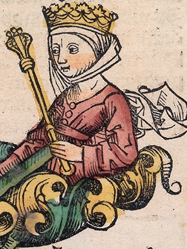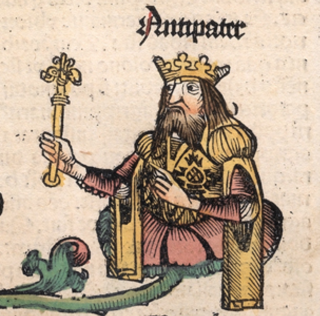Related Research Articles

Herod I or Herod the Great was a Roman Jewish client king of the Herodian Kingdom of Judea. He is known for his colossal building projects throughout Judea. Among these works are the rebuilding of the Second Temple in Jerusalem and the expansion of its base—the Western Wall being part of it. Vital details of his life are recorded in the works of the 1st century CE Roman–Jewish historian Josephus.

Herod Agrippa, also known as Herod II or Agrippa I, was the last Jewish king of Judea. He was a grandson of Herod the Great and the father of Herod Agrippa II, the last known king from the Herodian dynasty. He was acquaintance or friend of Roman emperors and even played crucial roles in internal Roman politics.

Herod Agrippa II, officially named Marcus Julius Agrippa and sometimes shortened to Agrippa, was the last ruler from the Herodian dynasty, reigning over territories outside of Judea as a Roman client. Agrippa II fled Jerusalem in 66, fearing the Jewish uprising and supported the Roman side in the First Jewish–Roman War.

Salome, also known as Salome III, was a Jewish princess, the daughter of Herod II and princess Herodias. She was granddaughter of Herod the Great, and stepdaughter of Herod Antipas. She is known from the New Testament, where she is not named, and from an account by Flavius Josephus. In the New Testament, the stepdaughter of Herod Antipas demands and receives the head of John the Baptist. According to Josephus, she was first married to her uncle Philip the Tetrarch, after whose death she married her cousin Aristobulus of Chalcis, thus becoming queen of Armenia Minor.

Herodias was a princess of the Herodian dynasty of Judaea during the time of the Roman Empire. Christian writings connect her with the execution of John the Baptist.

Herod Antipas was a 1st-century ruler of Galilee and Perea. He bore the title of tetrarch and is referred to as both "Herod the Tetrarch" and "King Herod" in the New Testament, although he never held the title of king. He was a son of Herod the Great and a grandson of Antipater the Idumaean. He is widely known today for accounts in the New Testament of his role in events that led to the executions of John the Baptist and Jesus of Nazareth. His father, Herod the Great, was alleged to have ordered the Massacre of the Innocents, marking the earliest Biblical account of the concerns of the government in Jerusalem regarding Jesus's existence.

Berenice was the daughter of Costobarus and Salome I, the sister of Herod the Great.

Herod Archelaus was the ethnarch of Samaria, Judea, and Idumea, including the cities Caesarea and Jaffa, for nine years. He was the son of Herod the Great and Malthace the Samaritan, brother of Herod Antipas, and half-brother of Herod II. Archelaus came to power after the death of his father Herod the Great in 4 BC, and ruled over one-half of the territorial dominion of his father. Archelaus was removed by the Roman emperor Augustus when Judaea province was formed under direct Roman rule, at the time of the Census of Quirinius.

Herod of Chalcis, also known as Herod Pollio King of Chalcis, Herod V, and listed by the Jewish Encyclopedia as Herod II, was a son of Aristobulus IV, and the grandson of Herod the Great, Roman client king of Judaea. He was the brother of Herod Agrippa I and Herodias and ruled as the king of Chalcis in 41–48 CE.

Aristobulus V of Chalcis was a son of Herod of Chalcis and his first wife Mariamne. Herod of Chalcis, ruler of Chalcis in Iturea, was a grandson of Herod the Great through his father, Aristobulus IV. Mariamne was a granddaughter of Herod the Great through her mother, Olympias; hence Aristobulus was a great-grandson of Herod the Great on both sides of his family.

The Herodian dynasty was a royal dynasty of Idumaean (Edomite) descent, ruling the Herodian Kingdom of Judea and later the Herodian Tetrarchy as a vassal state of the Roman Empire. The Herodian dynasty began with Herod the Great, who assumed the throne of Judea, with Roman support, bringing down the century-old Hasmonean Kingdom. His kingdom lasted until his death in 4 BCE, when it was divided among his sons as a tetrarchy, which lasted for about 10 years. Most of those tetrarchies, including Judea proper, were incorporated into Judaea Province from 6 CE, though limited Herodian de facto kingship continued until Agrippa I's death in 44 CE and nominal title of kingship continued until 92 CE, when the last Herodian monarch, Agrippa II, died and Rome assumed full power over his de jure domain.

Alexandreion (Greek), or Alexandrium (Latin), called Sartaba in the Mishna and Talmud and Qarn Sartaba in Arabic, was an ancient hilltop fortress constructed by the Hasmoneans between Scythopolis and Jerusalem on a pointy barren hill towering over the Jordan Valley from the west. It was likely named after Hasmonean king Alexander Jannæus.

Mariamne I, also called Mariamne the Hasmonean, was a Hasmonean princess and the second wife of Herod the Great. Her parents, Alexandra Maccabeus and Alexander of Judaea, were cousins who both descended from Alexander Jannaeus. She was known for her great beauty, as was her brother Aristobulus III. Herod's fear of his Hasmonean rivals led him to execute all of the prominent members of the family, including Mariamne.

Salome I was the sister of Herod the Great and the mother of Berenice by her husband Costobarus, governor of Idumea. She was a nominal queen regnant of the toparchy of Iamnia, Azotus, Phasaelis from 4 BCE.
Mariamne III was a daughter of Aristobulus IV and Berenice.

Antipater II was Herod the Great's first-born son, his only child by his first wife Doris. He was named after his paternal grandfather Antipater the Idumaean. He and his mother were exiled after Herod divorced her between 43 BC and 40 BC to marry Mariamne I. However, he was recalled following Mariamne's fall in 29 BC and in 13 BC Herod made him his first heir in his will. He retained this position even when Alexander and Aristobulus rose in the royal succession in 12 BC, and even became exclusive successor to the throne after their execution in 7 BC.

The Herodian tetrarchy was a regional division of a client state of Rome, formed following the death of Herod the Great in 4 BCE. The latter's client kingdom was divided between his sister Salome I and his sons Herod Archelaus, Herod Antipas, and Philip. Upon the deposition of Herod Archelaus in 6 CE, his territories were transformed into a Roman province. With the death of Salome I in 10 CE, her domain was also incorporated into a province.
Olympias the Herodian was the daughter of Herod the Great and wife Malthace, a Samaritan. This was Herod's fourth marriage. Olympias' better known brothers were Herod Archelaus and Herod Antipas. She married Herod's nephew Joseph ben Joseph and bore him a daughter, Mariamne, who was the first wife of Herod of Chalcis and the mother of Aristobulus of Chalcis.

Cypros (1st-century) was a queen consort of Judea. She was married to king Herod Agrippa.

This article lists historical events that occurred between 1–100 in modern-day Lebanon or regarding its people.
References
- ↑ Pagán, Victoria Emma, ed. (2023-05-25). The Tacitus Encyclopedia (1 ed.). Wiley. doi:10.1002/9781119114567. ISBN 978-1-4443-5025-8.
- ↑ Aguilar, Grace (1870). The women of Israel; or, Characters and sketches from the holy Scriptures, and Jewish history. Groombridge & Sons.
- ↑ Josephus, Flavius (1762). The Works of Flavius Josephus. Translated Into English by Sir Roger L'Estrange ... To which are Prefixed, Two Discourses [by John Willes, with Notes by John Hudson] ... The Sixth Edition, Etc.